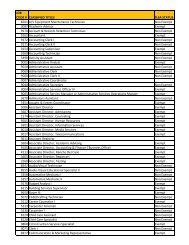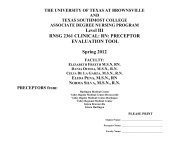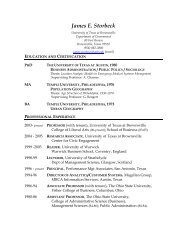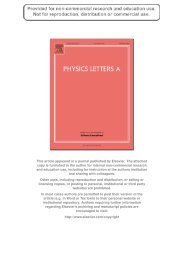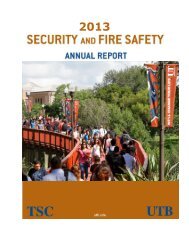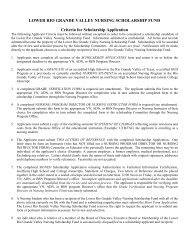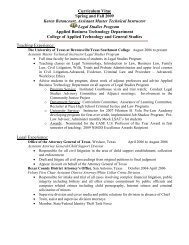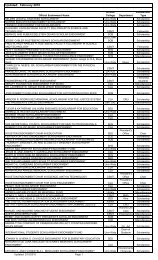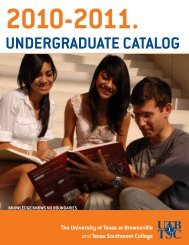beams_CNSNS1285
beams_CNSNS1285
beams_CNSNS1285
Create successful ePaper yourself
Turn your PDF publications into a flip-book with our unique Google optimized e-Paper software.
Author's personal copyN.H. Ibragimov, R.N. Ibragimov / Commun Nonlinear Sci Numer Simulat 15 (2010) 1989–2002 2001Invariant equations. We say that a system of equationsF k ðzÞ ¼0; k ¼ 1; ...; s ðA10Þis invariant with respect to the group G (or admits the group G) if the transformations (A1) of the group G map any solution ofEq. (A10) into a solution of the same equations, i.e.,F k ðzÞ ¼0; k ¼ 1; ...; s ðA11Þwhenever z solves Eq. (A10). The group G with the generator (A8) is admitted by Eq. (A10) if and only ifXðF k Þj ðA10Þ¼ 0; k ¼ 1; ...; s; ðA12Þwhere the symbol j ðA10Þmeans evaluated on the solutions of Eq. (A10).If z is a collection of independent variables x ¼ðx 1 ; ...; x n Þ, dependent variables u ¼ðu 1 ; ...; u m Þ and partial derivatives n ou ð1Þ ¼ u a i ; uð2Þ ¼ u a ij; ...,ofu with respect to x up to certain order, whereu a i¼ ouaox i ;u a ij ¼ o2 u aox i ox j ; ...then (A10) is a system of partial differential equationsF k ðx; u; u ð1Þ ; ...Þ¼0; k ¼ 1; ...; s: ðA13ÞFurthermore, if the transformations (A1) are obtained by the transformations of the independent and dependent variablesx ¼ f ðx; u; aÞ; u ¼ gðx; u; aÞ ðA14Þand the extension of (A14) to all derivatives u ð1Þ , etc. involved in the differential equation (A13), then Eq. (A11) define a groupG of transformations (A14) admitted by the differential equation (A13). In other words, an admitted group does not changethe form of the system of differential equation (A13). The generator of the admitted group G is termed an infinitesimal symmetry(or simply symmetry) of the differential equation (A13). Eq. (A12) serve for obtaining the infinitesimal symmetries andare known as the determining equations. These equations are linear and homogeneous and therefore the set L of its solutionsis a vector space. Integration of determining equations often provides several linearly independent infinitesimal symmetries.Moreover, the determining equations have a specific property that guarantees that the set L is closed with respect to thecommutator ½X 1 ; X 2 Š¼X 1 X 2 X 2 X 1 . Due to this property L is called a Lie algebra. If the dimension of the vector space L isequal to r, the space is denoted by L r and is called an r-dimensional Lie algebra. An r-dimensional Lie algebra L r generatesa group depending on r parameters which is called an r-parameter group.Invariant solutions. Let the differential equation (A13) admit a multi-parameter group G, and let H be a subgroup of G. Asolutionu a ¼ h a ðxÞ; a ¼ 1; ...; m ðA15Þof Eq. (A13) is called an H invariant solution (termed for brevity an invariant solution) if Eq. (A15) are invariant with respectto the subgroup H. IfH is a one-parameter group and has the generator X, then the H-invariant solutions are constructed bycalculating a basis of invariants J 1 ; J 2 ; .... The procedure has been clearly described in Section 3 (Eqs. (18) and (19)).References[1] Bell TH. Lee waves in stratified flows with simple harmonic time dependence. J Fluid Mech 1975;67:705–22.[2] Bluman GW, Anco SC. Symmetry and integration methods for differential equations. New York: Springer; 2002.[3] Bluman GW, Kumei S. Symmetries and differential equations. New York: Springer; 1989.[4] Cantwell BJ. Introduction to symmetry analysis. Cambridge: Cambridge University Press; 2002.[5] Cohen A. An introduction to the Lie theory of one-parameter groups with applications to the solution of differential equations. New York: D.C. Heath;1911.[6] Dalziel SB, Hughes GO, Sutherland BR. Whole field density measurements by synthetic schlieren. Exp Fluids 2000;28:322–37.[7] Dauxois T, Young WR. Near-critical reflection of internal waves. J Fluid Mech 1999;390:271–95.[8] Dickson LE. Differential equations from the group standpoint. Ann Math 1924;25:287.[9] Ibragimov NH, editor. CRC handbook of lie group analysis of differential equations. Applications in engineering and physical sciences, vol. 2. Boca Raton(FL): CRC Press; 1995.[10] Ibragimov NH, editor. CRC handbook of lie group analysis of differential equations. New trends in theoretical development and computationalmethods, vol. 3. Boca Raton (FL): CRC Press; 1996.[11] Ibragimov NH. Transformation groups applied to mathematical physics. Moscow: Nauka; 1983. English transl., Dordrecht: Reidel; 1985.[12] Ibragimov NH. Elementary Lie group analysis and ordinary differential equations. Chichester: Wiley; 1999.[13] Ibragimov RN. Resonant triad model for studying evolution of the energy spectrum among a large number of internal waves. Commun Nonlinear SciNumer Simul 2008;13:593–623.[14] Ibragimov RN. Oscillatory nature and dissipation of the internal waves energy spectrum in the deep ocean. Eur Phys J 2007;40:315–34.[15] Ibragimov RN. Generation of internal tides by an oscillating background flow along a corrugated slope. Phys Scripta 2008;78:065801.[16] Ibragimov RN. Stationary surface waves in a circular liquid layer with constant gravity. Quest Math 2000;23(1):1–12.[17] Ibragimov RN. Shallow water theory and solution of the problem on the atmospheric motion around a celestial body. Phys Scripta 2000;61:391–5.[18] Javam A, Imberger J, Armfield SW. Numerical study of internal wave-wave interactions in a stratified fluid. J Fluid Mech 2000;415:65–87.[19] Kistovich AV, Chashechkin YD. Nonlinear interactions of two dimensional packets of monochromatic internal waves. Izv Atmos Ocean Phys1991;27(12):946–51.




